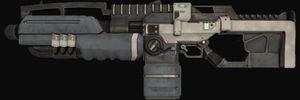Weapon Heavy ULA DK31
| DK-31 | |
|---|---|
 DK-31 | |
| Type | Laser Suspended Plasma Rifle |
| Service | |
| Used by | United League Army |
| Wars | Second Antarean War |
| Production | |
| Manufacturer | Corps-Miyaki |
| Unit cost |
70 combat 0 Support 0 Command |
| Specifications | |
| Weight | 7.5kg |
| Cartridge | GLSP 0.1mm |
| Operation | |
| Damage Inflicted | 53 |
| Rate of fire | 8.3 /s |
| Optimal range | 4000 uu |
| Secondary Firing Mode | Charged AV |
| Magazine | 40 rounds |
| Spare Magazines | 5 |
| Mod slots |
1x Sights 1x Underslung 2x Body |
|
| |
The DK-31 is a breakthrough for the ULA, after a long search for an advanced infantry weapon that could rival the AIA's fearsome EVR heavy rifle.
Where the driving force for the AIA has been the advancement of magnetic delivery of energy projectiles, the research team at Corps-Miyaki had considerably more success in another avenue; laser suspended plasma.
The DK-31 is essentially a laser weapon that channels plasma energy along the laser beam by ionizing a path, "injecting" it into the first substantial matter it meets. The rear of the weapon houses a power cell and a high-power short-burst fluoride laser which is focused through the breech into the chamber and down the barrel.
The specially developed 0.1mm GLSP class ammunition provides the plasmatic material. when a round is chambered and fired, the shell detonates a small plasma packet which is released into the barrel where it is accelerated by the laser towards lightspeed. whilst suspended in the beam, the plasma remains inert, but as soon as it reaches a point where the beam is broken, the plasmatic matter returns to a highly volatile state, releasing massive amounts of thermal and kinetic energy.
The benefit of this technique is a rapid fire, pinpoint beam weapon which is highly effective at anti-infantry work.
The weapon can preload 5 GLSP rounds to increase the density of the plasma, thereby acting as a longer-range, more powerful designated marksman weapon with anti-vehicular applications.
The drawbacks include a huge amount of heat generation, the DK-31's thermal sensors trip after approximately five seconds of continuous firing, and if it is run too hot for too long, the danger of the magazine becoming fractured increases.
When the magazine fractures (as has all too often been recorded), the plasma packets, designed to be kept in a vacuum within the magazine, implode and release their charge in a spectacular chain reaction vaporizing the weapon, it's owner and up to several cubic meters of the surrounding environment. As a result, almost none of the troops issued with this weapon wear it with the regulation strap and webbing clip.
In addition to the dangers, this cutting edge rifle is profoundly expensive to manufacture and operate; however, when used properly it has been extremely successful in special operations.
| ||||||||||||||||||